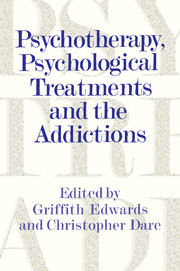Book contents
- Frontmatter
- Contents
- List of contributors
- Psychotherapy and psychological treatments of substance problems: generalism, specialism and the building of bridges
- Acknowledgements
- Part one Backgrounds to therapeutic understanding
- Part two Treatments
- 5 Psychotherapy: why do some need more and some need less?
- 6 Addictive behaviour: the next clinic appointment
- 7 Advances in families and couples therapy
- 8 Solution focused brief therapy: a co-operative approach to work with clients
- 9 Recent developments in cognitive and behavioural therapies
- 10 Cognitive and behavioural treatments for substance misuse
- 11 Motivational issues in the treatment of addictive behaviour
- 12 Can ‘stages of change’ provide guidance in the treatment of addictions? A critical examination of Prochaska and DiClemente's model
- 13 Group therapy and the addictions
- 14 Alcoholics Anonymous as mirror held up to nature
- 15 How therapeutic communities work
- Part three Postscript
- Index
15 - How therapeutic communities work
from Part two - Treatments
Published online by Cambridge University Press: 05 August 2016
- Frontmatter
- Contents
- List of contributors
- Psychotherapy and psychological treatments of substance problems: generalism, specialism and the building of bridges
- Acknowledgements
- Part one Backgrounds to therapeutic understanding
- Part two Treatments
- 5 Psychotherapy: why do some need more and some need less?
- 6 Addictive behaviour: the next clinic appointment
- 7 Advances in families and couples therapy
- 8 Solution focused brief therapy: a co-operative approach to work with clients
- 9 Recent developments in cognitive and behavioural therapies
- 10 Cognitive and behavioural treatments for substance misuse
- 11 Motivational issues in the treatment of addictive behaviour
- 12 Can ‘stages of change’ provide guidance in the treatment of addictions? A critical examination of Prochaska and DiClemente's model
- 13 Group therapy and the addictions
- 14 Alcoholics Anonymous as mirror held up to nature
- 15 How therapeutic communities work
- Part three Postscript
- Index
Summary
The concept and its definition
The term therapeutic community was coined by Lt Colonel Tom Main, RAMC in ‘The hospital as a therapeutic instition’ (Main, 1946). Later he referred to the therapeutic community as a ‘culture of enquiry … into personal and interpersonal and intersystem problems and a study of impulses, defences, and relations as these are expressed and arranged socially’ (Main, 1983). In the same paper he acknowledged that the term therapeutic community owed most of its meaning to Maxwell Jones whose ‘innovative work, especially wth psychopaths at the Social Rehabilitation Unit of Belmont Hospital (now called Henderson Hospital) and voluminous writings about his own percepts and practices have much influenced others’. The following extracts from the work of Tom Main (Main, 1946) and Maxwell Jones (Jones, 1952, 1956, 1968), illustrate some of their respective pioneering contributions to the concept of therapeutic community, which are still pertinent to current clinical practice.
Main referred to the therapeutic community as ‘an attempt to use a hospital not as an organisation run by doctors in the interests of their own greater technical efficiency, but as a community with the immediate aim of full participation of all its members in its daily life with the eventual aim of re-socialisation of the neurotic individual for life in ordinary society’. He continued that it should be, ideally, ‘a spontaneous and emotionally structured organisation rather than one which is medically dictated’. He stressed ‘the importance of the daily life of the therapeutic community being related to real tasks, i.e. those which are truly relevant to the needs and aspirations of the small society of the hospital, together with the larger society in which it is set’. He acknowledged that these were ‘not small requirements … [and that they] demanded a review of our own attitudes as psychiatrists towards our own status and responsibilities’. One result was that the doctor would no longer be seen, and would not see himself or herself, as owning patients. Rather, the patients would be ‘given up to the community which is to treat them and [which] owns him and them’.
- Type
- Chapter
- Information
- Psychotherapy, Psychological Treatments and the Addictions , pp. 240 - 256Publisher: Cambridge University PressPrint publication year: 1996



